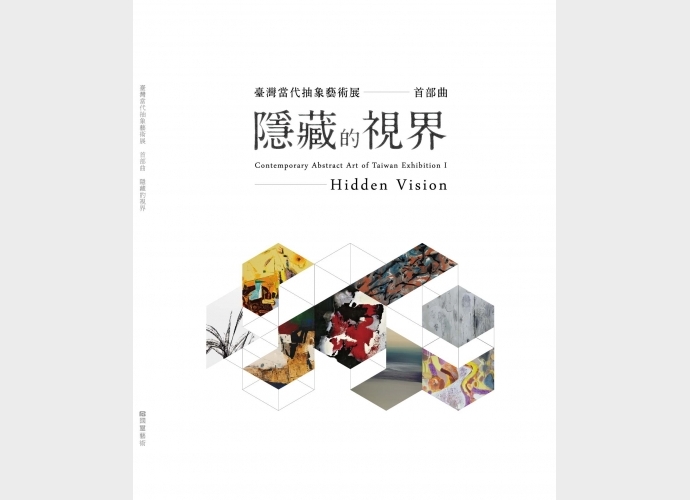
Contemporary Abstract Art of Taiwan ExhibitionⅠ-Hidden Vision 台灣當代抽象藝術展 - 首部曲
Apr 1, 2018
- Category: Others
- Format: UV color printing, 80 pages, perfect binding
- Size: 23.5 X 28.5 cm
- Price: 600
Taiwan Contemporary Abstract Art Exhibition – Chapter One: Hidden Vision
Curator / Kung-Tse WANG
The naked eye often stops at the surface of things, while the mind’s eye can perceive beyond appearances—into a hidden vision.
Abstract art, which departs from the imitation of external objects to explore pure form and color, is one of humanity’s greatest artistic achievements since the 20th century. With over a century of development, abstract art is often broadly categorized into two major directions: “cold abstraction” and “hot abstraction,” or alternatively, “geometric abstraction” and “lyrical abstraction.” While abstract art may no longer be the dominant trend in contemporary global art, it continues to shine in the 21st-century art world. Artists persist in expanding its boundaries and vision through diverse perspectives and techniques. These ever-evolving expressions affirm that abstract art has not been swept away by the tides of contemporary artistic evolution, but instead remains a classic form with enduring vitality and potential.
Taiwan’s first major wave of abstract art emerged in the early 1960s and already demonstrated a distinct approach to form and color from that of the West. The pioneering abstract artists in Taiwan grafted the aesthetics of Western abstraction with the ink-wash traditions of Eastern painting—particularly the Chinese philosophy of balancing negative and positive space (the “white of ink”). Their explorations were grounded in the formal studies of Western abstraction but were conceptually enriched by Chinese philosophical thought. Thus, Taiwan’s abstract art was not merely a product of Western modernism, but a unique hybrid, shaped by local cultural aesthetics that fostered new and original expressions.
Abstract art in Taiwan still holds vast possibilities. Given Taiwan’s multicultural identity and the influence of globalization, how do artists today respond to the abstract art of our era?
Hidden Vision, the first chapter of the Taiwan Contemporary Abstract Art Exhibition, focuses on eight mid-career artists born between 1960 and 1969: Wang Wei-He, Ke Ying-Ping, Kao Chi-Wei, His Chi WU, Chang Fu-Chun, Chiou Yueh HUANG, Shih Chung KO, and Hsu Shih-Fang. This generation, born during the peak of Taiwan’s abstract movement in the 1960s, differs from the earlier May and Eastern Painting Society artists, who carried strong nationalistic missions. These artists have returned to the self, demonstrating a deep creative self-awareness.
On one hand, they have been nourished by the achievements of earlier abstract pioneers; on the other hand, many among them studied abroad in Europe and the U.S., engaging deeply with the contemporary development of abstraction. With a global perspective, they have each forged their own creative trajectories, showcasing the unique identities of their abstract practices.
Through the curated selection of works by these eight artists, this exhibition presents a vibrant overview of the current landscape of abstract painting in Taiwan.
......................
臺灣當代抽象藝術展 首部曲-隱藏的視界
策展人/ 王公澤
透過肉眼容易只停留在事物的表象,透過心眼感知則可穿越表象,通向隱藏的視界。
抽象藝術脫離對外在物象的模仿,進入純粹造形與色彩的構成,是二十世紀以來人類最偉大的藝術成就之一。抽象藝術發展超過百年,它的脈絡與架構常常被概括的區分為「冷抽象」與「熱抽象」或稱「幾何抽象」與「抒情抽象」兩大方向。以目前全球藝術發展的趨勢看來,抽象藝術雖然已不是熱門的創作方向,但是抽象藝術卻仍然閃耀於二十一世紀的藝壇,持續有藝術家不斷以不同的觀點與技法,拓展抽象藝術的視野與疆界,演繹出豐富多樣的形式樣貌,而不被當代藝術的革新進化論所淹沒,再再顯示出抽象藝術仍然具有持續發展的動能與潛力,抽象已然成為藝術中的經典形式。
60年代初期臺灣抽象藝術的第一波高峰已呈現出有別於西方抽象藝術的形色思考,這些臺灣的前輩抽象畫家們,將西方抽象藝術與東方水墨計白守黑的美學接枝,著重在西方抽象繪畫形式的探索和研究上,積極以融合中西的概念,納入了中國哲學的意識型態,而產生了新的成果。由此可知臺灣的抽象藝術,並非完全由「西方現代主義以來的抽象藝術」生成滋養,而是融入了一些自身的文化美學,發展出不同形態的抽象表達。
抽象藝術在臺灣仍然具備多元的可能性,以臺灣多元的文化特質與全球化的影響,藝術家如何作出回應我們所屬世代的抽象藝術?臺灣當代抽象藝術展首部曲-隱藏的視界,聚焦在1960~1969所謂五年級生的八位中生代藝術家:王為河、柯應平、高其偉、吳熙吉、張富峻、黃秋月、柯適中與許世芳,他們出生於臺灣抽象藝術第一波高峰的60年代,跟五月、東方畫會具有國族使命色彩的那一代已不相同,他們回到個體,具有高度的創作自覺。一方面他們受教或得益於前輩抽象藝術家的養分,另一方面他們之中有許多位都曾留學歐美,對抽象藝術進行了深刻的當代性研究,以放眼全球的視野建構了屬於自己的創作脈絡,展現出個人抽象藝術的獨特性。本展透過這八位中生代藝術家抽象作品的抽樣,來呈現臺灣當代抽象繪畫藝術多元發展的現況。
............
Curator / Kung-Tse WANG
The naked eye often stops at the surface of things, while the mind’s eye can perceive beyond appearances—into a hidden vision.
Abstract art, which departs from the imitation of external objects to explore pure form and color, is one of humanity’s greatest artistic achievements since the 20th century. With over a century of development, abstract art is often broadly categorized into two major directions: “cold abstraction” and “hot abstraction,” or alternatively, “geometric abstraction” and “lyrical abstraction.” While abstract art may no longer be the dominant trend in contemporary global art, it continues to shine in the 21st-century art world. Artists persist in expanding its boundaries and vision through diverse perspectives and techniques. These ever-evolving expressions affirm that abstract art has not been swept away by the tides of contemporary artistic evolution, but instead remains a classic form with enduring vitality and potential.
Taiwan’s first major wave of abstract art emerged in the early 1960s and already demonstrated a distinct approach to form and color from that of the West. The pioneering abstract artists in Taiwan grafted the aesthetics of Western abstraction with the ink-wash traditions of Eastern painting—particularly the Chinese philosophy of balancing negative and positive space (the “white of ink”). Their explorations were grounded in the formal studies of Western abstraction but were conceptually enriched by Chinese philosophical thought. Thus, Taiwan’s abstract art was not merely a product of Western modernism, but a unique hybrid, shaped by local cultural aesthetics that fostered new and original expressions.
Abstract art in Taiwan still holds vast possibilities. Given Taiwan’s multicultural identity and the influence of globalization, how do artists today respond to the abstract art of our era?
Hidden Vision, the first chapter of the Taiwan Contemporary Abstract Art Exhibition, focuses on eight mid-career artists born between 1960 and 1969: Wang Wei-He, Ke Ying-Ping, Kao Chi-Wei, His Chi WU, Chang Fu-Chun, Chiou Yueh HUANG, Shih Chung KO, and Hsu Shih-Fang. This generation, born during the peak of Taiwan’s abstract movement in the 1960s, differs from the earlier May and Eastern Painting Society artists, who carried strong nationalistic missions. These artists have returned to the self, demonstrating a deep creative self-awareness.
On one hand, they have been nourished by the achievements of earlier abstract pioneers; on the other hand, many among them studied abroad in Europe and the U.S., engaging deeply with the contemporary development of abstraction. With a global perspective, they have each forged their own creative trajectories, showcasing the unique identities of their abstract practices.
Through the curated selection of works by these eight artists, this exhibition presents a vibrant overview of the current landscape of abstract painting in Taiwan.
......................
臺灣當代抽象藝術展 首部曲-隱藏的視界
策展人/ 王公澤
透過肉眼容易只停留在事物的表象,透過心眼感知則可穿越表象,通向隱藏的視界。
抽象藝術脫離對外在物象的模仿,進入純粹造形與色彩的構成,是二十世紀以來人類最偉大的藝術成就之一。抽象藝術發展超過百年,它的脈絡與架構常常被概括的區分為「冷抽象」與「熱抽象」或稱「幾何抽象」與「抒情抽象」兩大方向。以目前全球藝術發展的趨勢看來,抽象藝術雖然已不是熱門的創作方向,但是抽象藝術卻仍然閃耀於二十一世紀的藝壇,持續有藝術家不斷以不同的觀點與技法,拓展抽象藝術的視野與疆界,演繹出豐富多樣的形式樣貌,而不被當代藝術的革新進化論所淹沒,再再顯示出抽象藝術仍然具有持續發展的動能與潛力,抽象已然成為藝術中的經典形式。
60年代初期臺灣抽象藝術的第一波高峰已呈現出有別於西方抽象藝術的形色思考,這些臺灣的前輩抽象畫家們,將西方抽象藝術與東方水墨計白守黑的美學接枝,著重在西方抽象繪畫形式的探索和研究上,積極以融合中西的概念,納入了中國哲學的意識型態,而產生了新的成果。由此可知臺灣的抽象藝術,並非完全由「西方現代主義以來的抽象藝術」生成滋養,而是融入了一些自身的文化美學,發展出不同形態的抽象表達。
抽象藝術在臺灣仍然具備多元的可能性,以臺灣多元的文化特質與全球化的影響,藝術家如何作出回應我們所屬世代的抽象藝術?臺灣當代抽象藝術展首部曲-隱藏的視界,聚焦在1960~1969所謂五年級生的八位中生代藝術家:王為河、柯應平、高其偉、吳熙吉、張富峻、黃秋月、柯適中與許世芳,他們出生於臺灣抽象藝術第一波高峰的60年代,跟五月、東方畫會具有國族使命色彩的那一代已不相同,他們回到個體,具有高度的創作自覺。一方面他們受教或得益於前輩抽象藝術家的養分,另一方面他們之中有許多位都曾留學歐美,對抽象藝術進行了深刻的當代性研究,以放眼全球的視野建構了屬於自己的創作脈絡,展現出個人抽象藝術的獨特性。本展透過這八位中生代藝術家抽象作品的抽樣,來呈現臺灣當代抽象繪畫藝術多元發展的現況。
............
